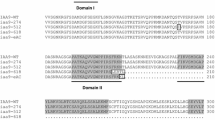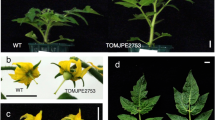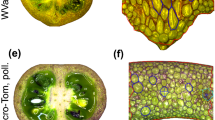Summary
Theparthenocarpic fruit (pat) allele causes a complex syndrome affecting different aspects of tomato reproductive development. This mutation affects stamen (reduced length and carpelloidy), ovule (arrested integument growth and unviability), and ovary (autonomous growth, i.e., parthenocarpy) development;pat mutant plants therefore have reduced male and female fertility. We studied the phenotypic expression patterns of thepat gene after treatments with gibberellic acid (GA3) and under different growth seasons (late spring and autumn) and genetic backgrounds (backcross [BC] population after interspecific cross). GA3 treatments were only effective in restoring carpelloid anthers to the wild-type phenotype. Compared to late spring, mutant plants grown in autumn had a lower frequency of carpelloid anthers and aberrant ovules and a higher seed set. Inflorescence position also affected thepat expression; upper inflorescences had low frequency of short anthers and aberrant ovules and an increased tendency to set seeds,pat expressivity was more variable in BC1 plants segregating after interspecific cross withLycopersicon pennellii than in the originalL. esculentum line. Therefore, a role for minor genes that modify the quantitative expression of thepat mutation is postulated and discussed.
Similar content being viewed by others
Abbreviations
- ANOVA:
-
analysis of variance
- BC:
-
backcross
- GA:
-
gibberellic acid
References
Acquaah G, Saunders JW, Ewart LC (1992) Homeotic floral mutations. Plant Breed Rev 9: 63–99
Alabadí D, Agüero MS, Perez-Amador MA, Carbonell J (1996) Arginase, arginine decarboxilase, and polyamines in tomato ovaries. Plant Physiol 112: 1237–1244
Bianchi A, Soressi GP (1969) Mutanti di pomodoro artificialmente indotti suscettibili di utilizzazione nel miglioramento genetico. Sementi Elette 15 (3): 2–6
Bowman JL, Smyth DR, Meyerowitz EM (1991) Genetic interactions among floral homeotic genes ofArabidopsis. Development 112: 1–20
Bünger-Kibler S, Bangerth F (1982/83) Relationship between cell number, cell size and fruit size of seeded fruits of tomato (Lycopersicon esculentum Mill.), and those induced parthenocarpically by the application of plant growth regulators. Plant Growth Regul 1: 143–154
Estruch JJ, Granell A, Hansen G, Prinsen E, Reding P, Van Onckelen H, Schwarz-Sommer Z, Sommer H, Spena A (1993) Floral development and expression of floral homeotic genes are influenced by cytokinins. Plant J 4: 379–384
Falavigna A, Badino M, Soressi GP (1978) Potential of the monomendelian factorpat in the tomato breeding for industry. Genet Agrar 32: 159–160 (abstract)
Nester JE, Zeevaart JAD (1988) Flower development in normal tomato and a gibberellin-deficient (ga-2) mutant. Am J Bot 75: 45–55
Gillaspy G, Ben-David H, Gruissem W (1993) Fruits: a developmental perspective. Plant Cell 5: 1439–1451
Goldberg RB (1988) Plants: novel developmental processes. Science 240: 1460–1467
Jacobsen SE, Shi L, Xin Z, Olszewski NE (1994) Gibberellin-induced changes in the translatable mRNA populations of stamens and shoots of gibberellin-deficient tomato. Planta 192: 372–378
Lang JD, Ray S, Ray A (1994)sin1, a mutation affecting female fertility in Arabidopsis, interacts withmod1, its recessive modifier. Genetics 137: 1101–1110
Lozano R, Angosto T, Gómez P, Payan C, Capel J, Huijser P, Salinas J, Martínez-Zapater JM (1998) Tomato flower abnormalities induced by low temperatures are associated with changes of expression of MADS-box genes. Plant Physiol 117: 91–100
Mapelli S, Frova C, Torti G, Soressi GP (1978) Relationship between set, development and activities of growth regulators in tomato fruits. Plant Cell Physiol 19: 1281–1288
—, Torti G, Badino M, Soressi GP (1979) Effects of GA3 on flowering and fruit-set in a mutant of tomato. HortSci 14: 736–737
Mazzucato A, Taddei AR, Soressi GP (1998) Theparthenocarpic fruit (pat) mutant of tomato (Lycopersicon esculentum Mill.) sets seedless fruits and has aberrant anther and ovule development. Development 125: 107–114
Okamuro JK, den Boer BGW, Jofuku KD (1993) Regulation of Arabidopsis flower development. Plant Cell 5: 1183–1193
—, Szeto W, Lotys-Prass C, Jofoku KD (1997) Photo and hormonal control of meristem identity in the Arabidopsis flower mutantsapetala2 andapetalal. Plant Cell 9: 37–47
Pharis RP, King RW (1985) Gibberellins and reproductive development in seed plants. Annu Rev Plant Physiol 36: 517–568
Philouze J, Pecaut P (1986) Parthénocarpie naturelle chez la tomate III: etude de la parthénocarpie due au gènepat (parthenocarpic fruit) de la lignée “Montfavet 191”. Agronomie 6: 243–248
Reid DM, Beall FD, Pharis RP (1991) Environmental cues in plant growth and development. In: Steward FC, Bidwell RGS (eds) Plant physiology: a treatise, vol 10, growth and development. Academic Press, Orlando, pp 65–181
Robinson-Beers K, Pruitt RE, Gasser CS (1992) Ovule development in wild-typeArabidopsis and two female sterile mutants. Plant Cell 4: 1237–1249
Sawhney VK (1983) The role of temperature and its relationship with gibberellic acid in the development of floral organs of tomato (Lycopersicon esculentum). Can J Bot 61: 1258–1265
—, (1994) Genic male sterility in tomato and its manipulation in breeding. In: Williams EG, Clarke AE, Knox RB (eds) Genetic control of self-incompatibility and reproductive development in flowering plants. Kluwer, Dordrecht, pp 443–458
—, Greyson RI (1971) Induction of multilocular ovary in tomato by gibberellic acid. J Am Soc Hort Sci 96: 196–198
— —, (1973) Morphogenesis of thestamenless-2 mutant in tomato II: modifications of sex organs in the mutant and normal flowers by plant hormones. Can J Bot 51: 2473–2479
Weigel D (1995) The genetics of flower development: from floral induction to ovule morphogenesis. Annu Rev Genet 29: 19–39
—, Meyerowitz EM (1994) The ABCs of floral homeotic genes. Cell 78: 203–209
Yanofsky MF (1995) Floral meristems to floral organs: genes controlling early events inArabidopsis flower development. Annu Rev Plant Physiol Plant Mol Biol 46: 167–188
Zachgo S, de Andrade Silva E, Motte P, Tröbner W, Saedler H, Schwarz-Sommer Z (1995) Functional analysis of theAntirrhinum floral homeoticDEFICIENS gene in vivo and in vitro by using a temperature-sensitive mutant. Development 121: 2861–2875
Author information
Authors and Affiliations
Corresponding author
Rights and permissions
About this article
Cite this article
Mazzucato, A., Testa, G., Biancari, T. et al. Effect of gibberellic acid treatments, environmental conditions, and genetic background on the expression of theparthenocarpic fruit mutation in tomato. Protoplasma 208, 18–25 (1999). https://doi.org/10.1007/BF01279071
Received:
Accepted:
Issue Date:
DOI: https://doi.org/10.1007/BF01279071




